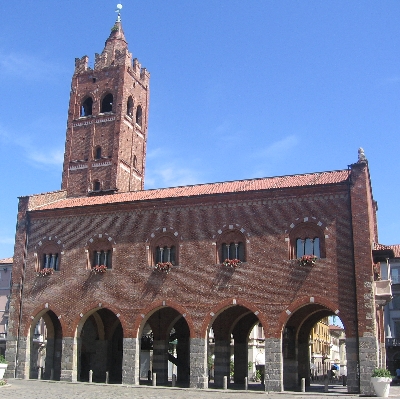Arengario
Centre of power of the Commune, the Arengario (corresponding to the type of Town Hall widespread in Italy during the 13th century) was built around 1290, aligned with the main road linking Monza to Milan, in one direction and, in the other, to Brianza. Once completed, the building fulfilled the civic functions that until then had been carried out in the portico of San Giovanni Battista. It is a sign of the equilibrium reached between the powers of the commune and those of the powerful arch-priest of the Cathedral.
The very location of the Aregnario in the town had the strong symbolic value of representing the importance achieved by the commune as an institution. The building was erected - close to the Cathedral, the centre of ecclesiastical power - in a central position with respect to the layout of the town and on the border of the area dedicated to trade, the market square (pratum magnum). The building stressed the affluence and the economic power achieved by the civitas of Monza thanks to the laboriousness of its population in farming and manufacturing. In the 12th century, encouraged by the Order of the Humiliati, the woollen and dyeing industries had become established, gradually followed by sericulture and the production of silk.
Next to the Arengario (the etymology recalls the early Germanic “hari-hring”, or "meeting place", easily borrowed from Longobard speech) stood the palace of the Podestà, now demolished, which was connected to the site of the people's assemblies by an overhead passage. The ground floor of the Arengario has an arched porch, for meetings and trade. Weights and measures used to be kept here at the disposal of mediaeval merchants for their trading activity.
On the first floor - reached by external staircases, traces of which can still be seen on the east side of the Arengario - is a large hall with a trussed roof, which was used to administer government and justice. Opening onto it is a small stone loggia known as the “Parlera”, added to the building in 1380: from there, the decrees issued by the court of the commune were proclaimed to the people. The adjacent bell tower was added later (16th century). It is adorned with Ghibelline merlons and its peak reaches a height of 44 metres. However, the building suffered severe damage in the same century.
At present, the Arengario is used as an exhibition hall for art reviews and cultural events. The upper floor can be accessed by a staircase in the tower.
Contact info
- Piazza Roma 20900 Monza
- Lat 45.584451115809806, Long 9.275189518928528

